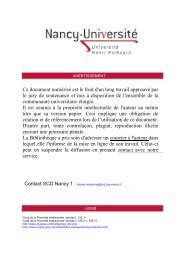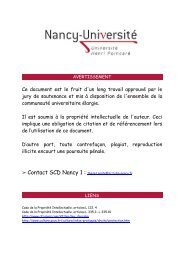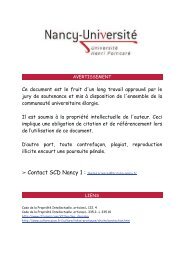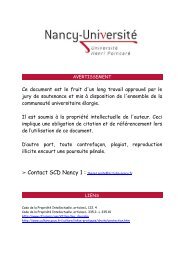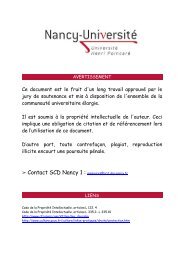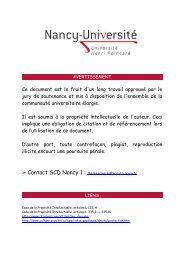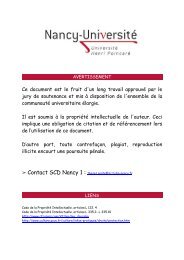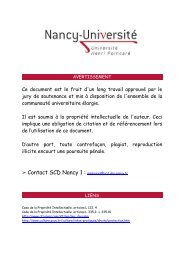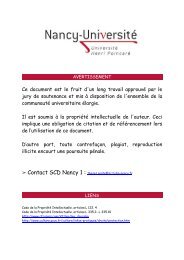Ce document numérisé est le fruit d'un long travail approuvé par le ...
Ce document numérisé est le fruit d'un long travail approuvé par le ...
Ce document numérisé est le fruit d'un long travail approuvé par le ...
Create successful ePaper yourself
Turn your PDF publications into a flip-book with our unique Google optimized e-Paper software.
604 Huin, Carriveau, Bianchi, Kel<strong>le</strong>r, Col<strong>le</strong>t, Krémarik-Bauillaud, Damenjaud, Bécuwe, Schahn, Ménard, Dauça<br />
et al. 1999). Severallines of evidence sugg<strong>est</strong> an early<br />
ro<strong>le</strong> of the fetal dig<strong>est</strong>ive tract in fat dig<strong>est</strong>ion. We<br />
have reported that peroxisomes with fatty acid f3-oxidation<br />
capacity are present in the fetal human gut (Dauça<br />
et al. 1996). The latter exhibits functional mechanisms<br />
to synthesize al! the lipid classes and to secrete them in<br />
the form of lipoproteins (Levy et al. 1992; Basque et<br />
al. 1998). Thus far, no studies have been devoted to<br />
the expression of PPARs in the developing human fetal<br />
dig<strong>est</strong>ive tract. Because the localization of these receptors<br />
may help to clarify the physiological ro<strong>le</strong>s of<br />
PPARs, this analysis was undertaken by immunohistochemistry<br />
in esophagus, stomach, smal! int<strong>est</strong>ine, and<br />
colon of human fetuses from Week 7 to Week 23 of<br />
development (WD). In this study we demonstrated a<br />
spatial and temporal distribution of PPARs in developing<br />
dig<strong>est</strong>ive tract that sugg<strong>est</strong>s a differential ro<strong>le</strong><br />
for these receptors during morphogenesis and cel! differentiation.<br />
Materials and Methods<br />
Tissue Specimens<br />
Samp<strong>le</strong>s of esophagus, stomach, int<strong>est</strong>ine, and colon from<br />
23 fetuses ranging from 7 to 22 weeks of age were obtained<br />
from normal e<strong>le</strong>ctive pregnancy terminations. The project<br />
was performed in accordance with the requirements of the<br />
Institutional Human Subject Review Board (University of<br />
Sherbrooke) for the use of human tissues. The latter were<br />
embedded in Polyfreeze Tissue Freezing Medium (Polysciences;<br />
Warrington, PA) and frozen in Iiquid nitrogen.<br />
Production of Anti-PPAR Antibodies<br />
As shown in Figure 1, the anti-PPARCl' antibody was raised<br />
against the amino acid sequence 4sSSGSFGFTEYQYs6 of<br />
human PPARCl' (Sher et al. 1993). The sequence 24EGAPE<br />
LNGGPQHAL37 of human NUCI (Schmidt et al. 1992) was<br />
used to produce the anti-PPAR13 polyclonal antibody. The<br />
anti-PPAR~/Y2 antiserum was raised against the amino acid<br />
sequence EMPFWPTNFGISSVD common to PPAR)'l and<br />
PPAR)'2 [amino acids 5-19 of mouse PPAR)'l (Zhu et al.<br />
1993); 35-49 of PPAR)'2 (Tontonoz et al. 1994)]. The sequence<br />
is weIl conserved in the two human PPAR)' isoforms<br />
(Elbrecht et al. 1996; Fajas et al. 1997). Taking advantage of<br />
the fact that the PPAR)'2 differs from the PPAR)'l by an additional<br />
specific N-terminal amino acid region, the sequence<br />
of the hapten used to produce the anti-human PPAR)'2 antibody<br />
was mapped at that region and corresponded to<br />
2GETLGDSPIDPESDS,6 of human PPAR)'2 (Elbrecht et al.<br />
1996; Fajas et al. 1997). The synthetic peptides were coupIed<br />
to keyho<strong>le</strong> limpet hemocyanin as a carrier according to<br />
the glutaraldehyde method (Avrameas 1969). Polyclonal antibodies<br />
were raised by SC injections into rabbits using standard<br />
procedures. In addition, we used a commercial anti<br />
PPAR)' antiserum (Interchim; Montluçon, France) directed<br />
against the amino acid sequence MMGEDKIKFKHITPL common<br />
to PPAR)'l and PPAR)'2 (amino acids 256-270 of human<br />
PPAR)'h 284-298 of human PPAR)'2).<br />
Characterization of the Antibodies<br />
The polyclonal antibodies produced were characterized by<br />
immunoprecipitation and W<strong>est</strong>ern blotting assays. In vitro<br />
transcription and translation of mouse PPARCl'/pSG5, PPAR13/<br />
pSG5, PPAR)'l/pSG5, and human PPAR)'2/pBluescript IIKS+<br />
plasmids (gift of Prof. W. WahIi; University of Lausanne, Switzerland)<br />
were performed using reticulocyte lysate (Promega;<br />
Charbonnières, France) and L-[35SJ-methionine. Translated<br />
products were either immunoprecipitated with the antibodies<br />
and analyzed by SDS-PAGE, followed by autoradiography,<br />
or directly submitted to W<strong>est</strong>ern blotting and enhanced<br />
chemiluminescence (ECL) in crossreaction assays.<br />
Adult and fetal colon mucosae were homogenized in 25<br />
mM Hepes buffer, pH 704, containing 004 M KCI, 1 mM<br />
EDTA, 2 mM dithiothreitol, and a cocktail of protease inhibitors<br />
(Comp<strong>le</strong>te; Roche, Mannheim, Germany). The homogenates<br />
were centrifuged at 15,000 X g for 20 min (4C).<br />
The protein concentration of the supernatant was determined<br />
(Bradford 1976). Samp<strong>le</strong>s were analyzed by W<strong>est</strong>ern<br />
blotting and ECL according to the manufacturer's protocol<br />
(Boehringer Mannheim Biochemica; Mannheim, Germany)<br />
using the different antibodies.<br />
Nuc<strong>le</strong>ase Protection Assay<br />
Partial human PPAR)'2 cDNA corresponding to the 5'UTR<br />
sequence (Fajas et al. 1997) was obtained by standard RT<br />
PCR using total RNA extracted from human adipocytes<br />
(Chomzynski and Sacchi 1987) and primers up (5'-CCCATC<br />
TCTCCCAAATATTT-3') and down (5'-GGGCCAGAAT<br />
GCGATCTCTGTG-3'). The resulting fragment (282 bp)<br />
was cloned into the pBSIIKS+ plasmid (Stratagene; La Jolla,<br />
CA), giving rise to the pBIIKS+/hPPAR)'2 vector. A pBIIKS+/<br />
hG3PDH clone containing a 380-bp DNA fragment of the<br />
human G3PDH encoding sequence (Tso et al. 1985) was<br />
produced using the same protocol and primers up (S'-CCC<br />
ATCACCATCTTCCGA-3') and down (5'-CTACAGGCC<br />
ACAGTTTCC-3'). Nuc<strong>le</strong>ase protection assay was carried out<br />
CIE 1<br />
t<br />
SSGSFGFTEYQY<br />
102 166 281 468<br />
LBO<br />
1 PPAR.<br />
74 138 253 441<br />
LBO 1 NUCI<br />
CIE<br />
t<br />
EGAPELNGGPQHAl<br />
[] ~<br />
1 ID' 173 2B8 478<br />
t<br />
EMPFWPTNFGISSVD<br />
t<br />
MMGEDKIKFKHITPl<br />
0 ~<br />
L80 1 PPARyl<br />
1<br />
+ 13' 203 t 318 506<br />
t<br />
GETlGDSPIDPESDS<br />
LBD 1 PPAR"<br />
Figure 1 Schematic com<strong>par</strong>ison of the different human PPAR subtypes<br />
vs PPARa. The positions of the peptides used ta produce the<br />
polyclanal antibadies are mapped. The DNA (DBD) and ligand<br />
(LBD) binding damains are represented.



